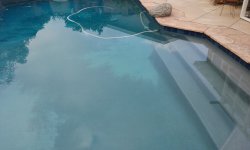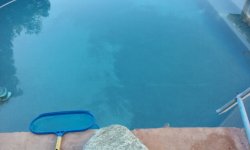Hi all,
Pool re-plastered in April of 2018. The mottling seems to have taken over in the last month. Is this something that can happen 4 years after re-plaster?
I did add 55 lbs. of boric acid 6 weeks ago to try to slow down the pH rise (that’s another post to come)
Also some of what I think are calcium nodules started appearing a couple months ago.
Does anyone know if this will eventually cover all the plaster? It wouldn’t be such an eye sore then.
FC – 5
pH – 7.8
TA – 65
CH – 650
CYA – 45
SALT – 2200
Borate – 38
CSI - .13
Thanks


Pool re-plastered in April of 2018. The mottling seems to have taken over in the last month. Is this something that can happen 4 years after re-plaster?
I did add 55 lbs. of boric acid 6 weeks ago to try to slow down the pH rise (that’s another post to come)
Also some of what I think are calcium nodules started appearing a couple months ago.
Does anyone know if this will eventually cover all the plaster? It wouldn’t be such an eye sore then.
FC – 5
pH – 7.8
TA – 65
CH – 650
CYA – 45
SALT – 2200
Borate – 38
CSI - .13
Thanks






